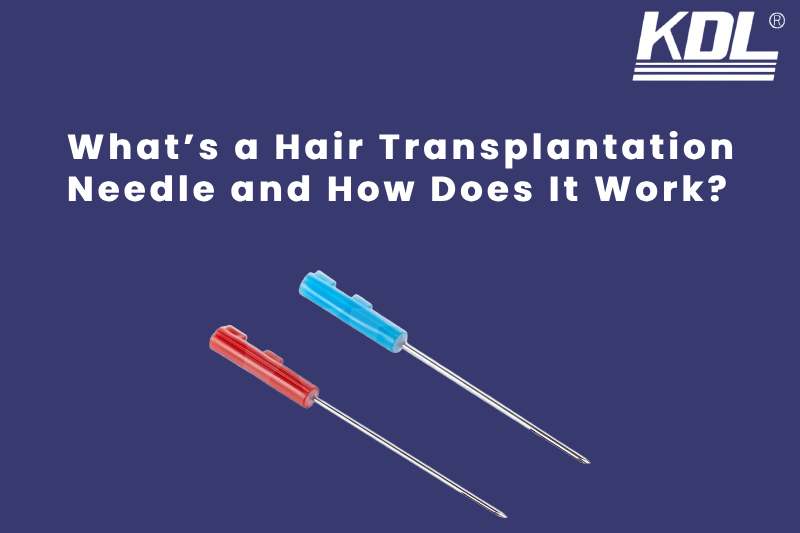
Hair transplantation has come a long way, evolving into a sophisticated procedure that delivers remarkable results for individuals facing hair loss. Central to the success of these procedures is the choice of tools—particularly the hair transplantation needles. But what exactly is a hair transplantation needle, and how does it work in procedures like Follicular Unit Extraction (FUE)? In this article, we’ll explore the role of these specialized needles, the types used, and why they are critical to the success of hair restoration.
What are the Hair Transplantation Needles?
Hair transplantation involves extracting hair follicles from a donor area (usually the back or sides of the head) and implanting them into areas where hair is thinning or balding. While various tools are use in this process, the needle is one of the most important. It serves as the vehicle through which hair follicles are extracted and implanted, playing a significant role in ensuring the survival of each follicle and the overall success of the transplant.
In hair restoration, precision is key, and hair transplantation needle are specially design to meet the unique needs of this delicate procedure. Whether it’s an FUE technique or a DHI (Direct Hair Implantation) method, the type of needle used can influence the result in terms of density, scarring, and natural-looking growth.
Types of Hair Transplantation Needles
FUE Hair Transplant Needles
In Follicular Unit Extraction (FUE), one of the most popular hair transplant methods today, the surgeon uses a fine punch needle to extract individual hair follicles from the donor area. These needles are design to be minimally invasive, creating tiny circular incisions around each follicle. The smaller the needle, the less visible scarring, and the quicker the recovery.
FUE needles are typically measure by their size, with diameters ranging from 0.6mm to 1.0mm. Smaller needles are often preferred because they allow for greater precision and minimize tissue trauma, reducing the risk of scarring and maximizing graft survival.
Implanter Pens and Slit Needles
In some advanced hair transplant techniques, such as Direct Hair Implantation (DHI), surgeons use an implanter pen instead of a traditional needle. A popular choice is the Choi implanter pen, which allows surgeons to both extract and implant the hair grafts in one motion. This tool uses a sharp, fine needle attached to a pen-like device that pushes the graft into the scalp without the need for pre-made incisions.
Another type is the slit needle, often used for creating recipient sites. The slit needle allows for a greater control over the angle, depth, and direction of the graft, which is critical for achieving a natural-looking result.
How Does a Hair Transplant Needle Work?
Extraction Phase
The first phase of a hair transplant procedure involves extracting individual hair follicles from the donor site, often located at the back of the head where hair is naturally more resistant to thinning. Using a micro-punch tool, which is essentially a fine needle, the surgeon carefully isolates each follicle, creating a small circular incision around it.
This step requires extreme precision, as the needle must avoid damaging the follicle during the extraction process. Damage to the follicles can reduce their survival rate, impacting the overall success of the procedure.
Implantation Phase
Once the follicles are extracted, they need to be implanted into the recipient area. During this phase, a fine needle is use to create tiny channels or slits where the follicles will be placed. The depth, angle, and direction of each slit are critical for ensuring that the hair grows in a way that looks natural.
In procedures like DHI, the same needle is use to both create the slit and implant the follicle simultaneously. This reduces the time the follicles spend outside the scalp, improving their survival rate.
Why Needle Choice is Critical in Hair Transplants
The choice of needle is one of the most important factors in a successful hair transplant. Here’s why:
- Precision and Control: The needle size and type influence how precisely the surgeon can place each graft. Smaller, sharper needles allow for better control, which is crucial for achieving natural-looking results, especially when working with smaller grafts.
- Minimizing Trauma: Hair transplant needles are design to minimize trauma to the scalp and hair follicles. Needles that are too large can damage surrounding tissue, increasing the risk of scarring. By contrast, needles designed for FUE or DHI are small and sharp enough to extract and implant hair without causing significant damage.
- Graft Survival: The longer a hair graft spends outside of the scalp, the lower its chance of survival. Specialized needles like the Choi implanter pen minimize this time by combining the extraction and implantation phases, improving overall success rates.
- Reduced Scarring: One of the key benefits of modern hair transplant techniques is the minimal scarring. Needles used in FUE and DHI create tiny incisions, which heal quickly and leave minimal to no visible scarring.
Looking for High-Quality Hair Transplantation Needles?
At KDL, we are proud to be a leading manufacturer and supplier of premium hair transplantation needle and equipment. Our products are design with precision and innovation to support hair restoration professionals in delivering successful, natural-looking results.
Explore our full range of hair transplant needle at kdlnc, and discover how our expertly engineered needles can enhance your practice. Whether you specialize in FUE, DHI, or other techniques, KDL offers the reliable products you need for exceptional outcomes. Contact us today.
Conclusion
The humble hair transplantation needle plays a pivotal role in the success of modern hair restoration procedures. Whether it’s the precise extraction of follicles or their careful implantation, the right needle ensures minimal trauma, high graft survival, and natural-looking results. As hair transplant technology advances, needles will continue to evolve, making the procedure more effective and less invasive for patients around the world.
 +86-791-8686-1216
+86-791-8686-1216 

